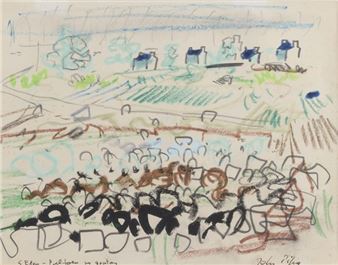The Power of the Sea
From the sublime spectacle of crashing waves to the vast and open expanse of the oceans, the sea has long fascinated artists in Britain. The Power of the Sea offers a multi-disciplinary approach to this fascinating subject, showcasing work by internationally-renowned contemporary artists alongside key historical works from national and regional art collections.
Many of the earliest artists in the exhibition - George Morland, Francis Danby, John Brett and Walter Langley - emphasized the Romanticism of the sea through images depicting the human costs of shipwrecks and their aftermath. Meanwhile JMW Turner and John Constable were captivated by its elemental nature – its fury and fluidity, breeze and light. By the late nineteenth century, the sea seemed more benign, a source of leisure and health: Henry Moore, David James, and Sydney Mortimer Laurence experimented with different ways to capture the movement of the waves. In the twentieth century Paul Nash, Edward Wadsworth and Paul Feiler found reassurance in the simple geometry of sea walls and boats, while Peter Lanyon, John Piper and Joan Eardley portrayed the coast as much more insubstantial, a place of swirling winds and shifting moods, reflecting personal experience.
In contemporary art, maritime environments have been both minimalist panoramas and places of familiarity and intimacy. Maggi Hambling, recognised for her celebrated series of North Sea Paintings, has depicted the power and energy of the sea in both paint and bronze. Gail Harvey creates colourful waves, while Kurt Jackson, Len Tabner and Janette Kerr depict seas that furiously foam and froth. The monochromatic photographs and etchings of James Beale, Norman Ackroyd and Thomas Joshua Cooper capture the moods, beauty and momentary movements of the ocean. History, memory, myth and maritime tradition inhabit the works of Hugh O'Donoghue and Will Maclean. Coastal erosion and rising sea levels are portrayed in work by Simon Read, Michael Porter and Jethro Brice, while Peter Matthews and Andrew Friend immerse work in the sea or create devices that deliberately disappear beneath its surface.
This significant exhibition demonstrates the contrasts and continuities in artists’ engagement with the sea over a period that spans more than two centuries. It encompasses a time of great change in man’s relationship with nature and the understanding of that relationship bringing us to the present day and the effects of climate change upon rising sea levels, which has only lent greater urgency to their work.

Recommended for you
From the sublime spectacle of crashing waves to the vast and open expanse of the oceans, the sea has long fascinated artists in Britain. The Power of the Sea offers a multi-disciplinary approach to this fascinating subject, showcasing work by internationally-renowned contemporary artists alongside key historical works from national and regional art collections.
Many of the earliest artists in the exhibition - George Morland, Francis Danby, John Brett and Walter Langley - emphasized the Romanticism of the sea through images depicting the human costs of shipwrecks and their aftermath. Meanwhile JMW Turner and John Constable were captivated by its elemental nature – its fury and fluidity, breeze and light. By the late nineteenth century, the sea seemed more benign, a source of leisure and health: Henry Moore, David James, and Sydney Mortimer Laurence experimented with different ways to capture the movement of the waves. In the twentieth century Paul Nash, Edward Wadsworth and Paul Feiler found reassurance in the simple geometry of sea walls and boats, while Peter Lanyon, John Piper and Joan Eardley portrayed the coast as much more insubstantial, a place of swirling winds and shifting moods, reflecting personal experience.
In contemporary art, maritime environments have been both minimalist panoramas and places of familiarity and intimacy. Maggi Hambling, recognised for her celebrated series of North Sea Paintings, has depicted the power and energy of the sea in both paint and bronze. Gail Harvey creates colourful waves, while Kurt Jackson, Len Tabner and Janette Kerr depict seas that furiously foam and froth. The monochromatic photographs and etchings of James Beale, Norman Ackroyd and Thomas Joshua Cooper capture the moods, beauty and momentary movements of the ocean. History, memory, myth and maritime tradition inhabit the works of Hugh O'Donoghue and Will Maclean. Coastal erosion and rising sea levels are portrayed in work by Simon Read, Michael Porter and Jethro Brice, while Peter Matthews and Andrew Friend immerse work in the sea or create devices that deliberately disappear beneath its surface.
This significant exhibition demonstrates the contrasts and continuities in artists’ engagement with the sea over a period that spans more than two centuries. It encompasses a time of great change in man’s relationship with nature and the understanding of that relationship bringing us to the present day and the effects of climate change upon rising sea levels, which has only lent greater urgency to their work.
Artists on show
- David James
- Edward Wadsworth
- Francis Danby
- Gail Harvey
- George Morland
- Henry Moore
- Hughie O'Donoghue
- Joan Kathleen Hardy Eardley
- John Brett
- John Piper
- Kurt Jackson
- Len Tabner
- Maggie Hambling
- Norman Ackroyd
- Paul Feiler
- Paul Nash
- Peter Lanyon
- Peter Matthews
- Simon Read
- Sydney Laurence
- Terry Setch
- Thomas Joshua Cooper
- Walter Langley
Contact details















